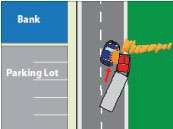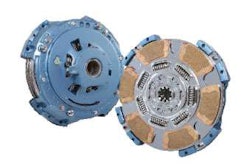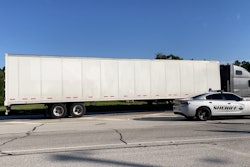NTSB calls for new safety technology
Event data recorders, collision warning systems on list
In late September, the National Transportation Safety Board called upon the Federal Motor Carrier Safety Administration to require all heavy commercial vehicles to be equipped with video event recorders, improve its fatigue educational materials and require all motor carriers to adopt a fatigue management program based on the North American Fatigue Management Program. In addition, NTSB urged the National Highway Traffic Safety Administration to set performance standards for event data recorders and require that all trucks more than 10,000 pounds GVWR be equipped with them.
 The National Transportation Safety Board released its latest safety technology recommendations following its investigation of a fatal accident involving a tractor trailer in Miami, Okla., on June 26, 2009.
The National Transportation Safety Board released its latest safety technology recommendations following its investigation of a fatal accident involving a tractor trailer in Miami, Okla., on June 26, 2009.“We must take advantage of technologies that can help us learn from our experiences and help change design, procedures or behavior – technologies like event data recorders and video recorders that provide valuable data on the status of the vehicle and the driver’s actions during the accident sequence,” said Deborah Hersman, NTSB chairman. “If we are serious about improving safety, we have to be more proactive.”
The recommendations followed a NTSB investigation of a multivehicle accident in June 2009 involving a tractor-trailer that killed 10 people near Miami, Okla. In its investigation report, the board determined that driver fatigue stemming from sleep loss, circadian disruption and sleep apnea were at fault. According to NTSB’s analysis, the 76-year-old truck driver failed to react to slowing and stopped traffic ahead by applying brakes or performing any evasive maneuvers to avoid a collision. The accident occurred shortly after a minor accident in the same area caused traffic to back up.
NTSB also reiterated previous recommendations to develop standards and require deployment of collision warning systems on new commercial vehicles, require energy-absorbing under-ride protection for trucks and develop technologies to reduce fatigue-related accidents. In total, NTSB issued nine new safety recommendations and reiterated six others in its report.
A synopsis of the accident investigation report – including the findings, probable causes and safety recommendations – can be found on the Board Meetings page of NTSB’s website, www.ntsb.gov/events/boardmeeting.htm.
IN BRIEF
* The Federal Motor Carrier Safety Administration disclosed the 30-month field test of its Comprehensive Safety Analysis 2010. Phase I indicated the test group reached 44 percent more carriers than the non-test group, while 62 percent of investigations included a follow-up with the carrier to address safety deficiencies, compared with 32 percent in the non-test group. Phase II preliminary results indicate the test group reached 37 percent more carriers than the non-test group and a 52 percent increase in the number of investigations per investigator.
* Qualcomm Enterprise Services will launch its CSA Safety Performance Service this month, providing customers with a safety assessment “scorecard” for their fleet and drivers. The system will combine real-time data and predictive analysis with a carrier’s existing safety data and CSA 2010 scores.
* The American Trucking Associations announced its President’s Trophy winners: ABF Freight System (over 100 million miles), Dupre Logistics (between 25-100 million miles) and TCW/Tennessee Express (under 25 million miles). Dean Newell of Maverick Transportation won the associations’ National Safety Director of the Year Award.
* Boyd Bros. Transportation honored two of its drivers – Virgil Shell of Columbia, S.C., and Dennis Howard of Goodwater, Ala. – who both recently logged two million consecutive safe miles with the Clayton, Ala.-based flatbed carrier.
* Lithonia, Ga.-based Brown Trucking inducted 13 drivers into its Driver Safety Hall of Fame for surpassing a million consecutive accident-free miles with the company.
PREVENTABLE OR NOT:
Doe couldn’t bank on bank customer
At 1 p.m. with a wide trailer in tow, trucker John Doe was northbound on narrow two-lane Bumpkin Boulevard, munching celery sticks and listening to Talk Radio WGAB, hosted this afternoon by Jim Bob Schwartz, who was rambling on about the November elections. The day was crisp and sunny, but traffic was fairly heavy, especially so in the southbound lane.
 John Doe attempted to squeak past a car making a left turn, but the car’s driver changed his mind, continued ahead and hit the fender of Doe’s tractor. Was this a preventable accident?
John Doe attempted to squeak past a car making a left turn, but the car’s driver changed his mind, continued ahead and hit the fender of Doe’s tractor. Was this a preventable accident?Looking ahead, Doe noticed that a blue Ford Mustang driven by habitually impatient and ill-tempered Kermit “Butch” Frogley had stopped, with his left turn signal flashing, waiting for an opportunity to turn left into the parking lot of the First Bank of Bumpkin. So Doe slowed to a stop, then after waiting a few moments attempted to squeak past the sports car, pulling partially onto the shoulder to complete the maneuver.
At that instant, Frogley decided that he’d have to wait all day to get into the bank’s parking lot, became frustrated and suddenly accelerated back into the center of his lane, which unfortunately was occupied by the fender of Doe’s tractor. WHUMMPO!!! Oh no!
Because Doe questioned the preventable-accident warning letter from his safety director, the National Safety Council’s Accident Review Committee was asked to settle the dispute. NSC immediately upheld the “preventable” ruling, noting that a defensive driver would have waited for the frantic Frogley to complete his turn instead of attempting to pass on the shoulder. n










